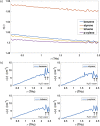Characterization of volatile organic compounds (VOCs) in their liquid-phase by terahertz time-domain spectroscopy
- PMID: 32010495
- PMCID: PMC6968772
- DOI: 10.1364/BOE.11.000001
Characterization of volatile organic compounds (VOCs) in their liquid-phase by terahertz time-domain spectroscopy
Abstract
In this work the terahertz spectra of benzene, toluene, p-xylene and styrene-four volatile organic compounds (VOCs) of interest in environmental pollution studies-have been measured in their liquid phase at room temperature using terahertz time-domain spectroscopy (THz-TDS). Their frequency-dependent refractive index and absorption coefficient have been extracted and analyzed in the spectral range from 0.2 to 2.5 THz. The optical properties of bi-component VOCs mixtures have also been investigated and described in terms of a linear combination of pure VOCs optical components.
© 2019 Optical Society of America under the terms of the OSA Open Access Publishing Agreement.
Conflict of interest statement
The authors declare that there are no conflicts of interest related to this article.
Figures



Similar articles
-
Terahertz continuous wave spectroscopy: a portable advanced method for atmospheric gas sensing.Opt Express. 2022 May 23;30(11):19005-19016. doi: 10.1364/OE.456022. Opt Express. 2022. PMID: 36221688
-
Investigation of Dielectric Properties of Polymers and their Discrimination Using Terahertz Time-Domain Spectroscopy with Principal Component Analysis.Appl Spectrosc. 2017 Mar;71(3):456-462. doi: 10.1177/0003702816675361. Epub 2016 Oct 27. Appl Spectrosc. 2017. PMID: 27798383
-
[Accurate optical parameters extracting of non-polar organic solvents in the terahertz range].Guang Pu Xue Yu Guang Pu Fen Xi. 2011 Nov;31(11):2886-90. Guang Pu Xue Yu Guang Pu Fen Xi. 2011. PMID: 22242478 Chinese.
-
[Progress in application of THz-TDS to protein study].Guang Pu Xue Yu Guang Pu Fen Xi. 2008 Oct;28(10):2237-42. Guang Pu Xue Yu Guang Pu Fen Xi. 2008. PMID: 19123380 Review. Chinese.
-
[Detection of amino acids based on terahertz spectroscopy].Guang Pu Xue Yu Guang Pu Fen Xi. 2009 Sep;29(9):2351-6. Guang Pu Xue Yu Guang Pu Fen Xi. 2009. PMID: 19950627 Review. Chinese.
Cited by
-
High Sensitivity Monitoring of VOCs in Air through FTIR Spectroscopy Using a Multipass Gas Cell Setup.Sensors (Basel). 2022 Jul 27;22(15):5624. doi: 10.3390/s22155624. Sensors (Basel). 2022. PMID: 35957181 Free PMC article.
-
Roadmap of Terahertz Imaging 2021.Sensors (Basel). 2021 Jun 14;21(12):4092. doi: 10.3390/s21124092. Sensors (Basel). 2021. PMID: 34198603 Free PMC article. Review.
References
-
- Khan F. I., Kr. Ghoshal A., “Removal of Volatile Organic Compounds from polluted air,” J. Loss Prev. Process Ind. 13(6), 527–545 (2000).10.1016/S0950-4230(00)00007-3 - DOI
-
- Liu Y., Shao M., Fu L., Lu S., Zeng L., Tang D., “Source profiles of volatile organic compounds (VOCs) measured in China: Part I,” Atmos. Environ. 42(25), 6247–6260 (2008).10.1016/j.atmosenv.2008.01.070 - DOI
-
- Al-Douseri F. M., Chen Y., Zhang X. C., “THz wave sensing for petroleum industrial applications,” Int. J. Infrared Millimeter Waves 27(4), 481–503 (2007).10.1007/s10762-006-9102-y - DOI
-
- Yu C., Crump D., “A Review of the Emission of VOCs from Polymeric Materials used in Buildings,” Build. Environ. 33(6), 357–374 (1998).10.1016/S0360-1323(97)00055-3 - DOI
LinkOut - more resources
Full Text Sources
